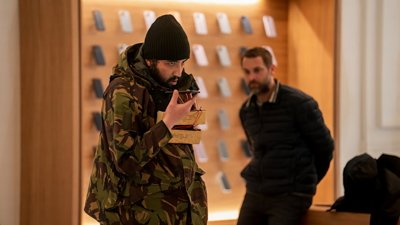The Chicago Sun-Times, one of the oldest daily newspapers in America, fired its entire pool of 28 photographers on Friday, and plans to source future graphics from reporters who will be trained to capture print-worthy images with their iPhones.
First reported by former Sun-Times columnist Robert Feder on Facebook (via Cult of Mac), the publication plans to give reporters mandatory training in "iPhone photography basics" as a replacement for the outgoing photographers. One of the fired photographers is Pulitzer Prize winner John H. White.
With smartphones, or camera-toting feature phones, being nearly ubiquitous, an increasing number of news outlets are turning to the pubic for immediate "on the scene" shots. For example, when a tornado ripped through Moore, Okla. on May 20, initial news coverage relied on photos from residents and storm chasers posting images to various social media sites.
From Feder's Facebook page:
Sun-Times reporters begin mandatory training today on "iPhone photography basics" following elimination of the paper's entire photography staff. "In the coming days and weeks, we'll be working with all editorial employees to train and outfit you as much as possible to produce the content we need," managing editor Craig Newman tells staffers in a memo.
It appears the Sun-Times is looking to use the iPhone's camera as a step-up from amateur-shot pictures currently used by Web and TV media.
A recent side-by-side comparison of photos taken by all six iPhone versions illustrates how the device has developed as a portable shooter.
While Apple's latest iPhone 5 takes image capture to new levels with an 8-megapixel CMOS sensor with glass optical elements and a man-made sapphire cover glass, it can't compete with modern digital SLRs, especially when those rigs are in the hands of a seasoned professional.
The Sun-Times is willing to take a chance, however, and believes that with the proper training, reporters can gather images at a quality high enough to publish.
 AppleInsider Staff
AppleInsider Staff








 Malcolm Owen
Malcolm Owen
 William Gallagher
William Gallagher
 Christine McKee
Christine McKee


 Charles Martin
Charles Martin



-m.jpg)






186 Comments
There's sadness in that story, but I suppose it's technology making other "norms" obsolete. Seems that all the photos we see lately comes from mobile devices anyways. I supposed it's not a surprise. Interesting it's all iPhones. Not one mention of Android devices.
Sad, so sad for those photographers. I take photography as a side hobby, and despite the massive improvements in phone cameras recently, those photos still cannot measure up to the dedicated high end cameras. Heck, it's easy enough to tell an image taken by an iPhone 5 and that taken by $600 Nikon/Canon prosumer DSLR. You paid $600 for a dedicated camera, versus $600 for a phone that just happens to also has a camera. Becoming a photog isn't easy. There are lots of training, interning, learning on the jobs, and yes, heavy investment in photo equipments. It's so sad to see a large newspaper ditching all the arts of photography and tell the photogs "just take pictures with your phone".
Sad, so sad for those photographers. I take photography as a side hobby, and despite the massive improvements in phone cameras recently, those photos still cannot measure up to the dedicated high end cameras. Heck, it's easy enough to tell an image taken by an iPhone 5 and that taken by $600 Nikon/Canon prosumer DSLR. You paid $600 for a dedicated camera, versus $600 for a phone that just happens to also has a camera.
Becoming a photog isn't easy. There are lots of training, interning, learning on the jobs, and yes, heavy investment in photo equipments. It's so sad to see a large newspaper ditching all the arts of photography and tell the photogs "just take pictures with your phone".
That's true. However, when most news is online and pictures are usually no more than 800x600, and printed magazines are slowly going out of style and read on tablets, SLR quality is not a necessity methink. It's sad.
This is stupid. Being a good photographer isn't just training. It's experience and creativity that's makes them shine. Just because you can take a pic of your cat doesn't make you a prof photog.
The best camera is the one you have on you.